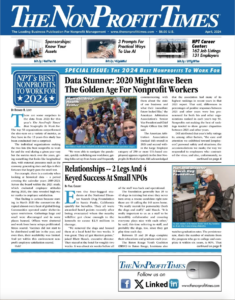It has long been a focus of attention to develop training for the frontline staff responsible for daily, point-of-work supervision of volunteers. But every project initiated at the top executive level must be implemented across and down the organizational ladder, relying along the way on the buy-in of middle managers: branch/affiliate directors, department heads, unit supervisors, and others for whom volunteers become a factor in their team’s effectiveness.
Are middle managers supportive of volunteer involvement or resistant? Do they understand their “once removed” volunteer support role? Do they have the skills necessary to help their direct reports develop volunteers for the greatest impact?
Most nonprofit staff are overworked and stretched thin already. Adding volunteers to the mix, while of great potential value in the long run, is not easy and definitely takes time. So the goal is to make sure the benefits of volunteer involvement outweigh the effort. It’s middle managers who can best monitor this balance and establish the importance of community engagement.
They can be great allies or obstacles to success. Consider:
- Middle managers convey overt and subtle messages to their direct reports about work expectations, setting the tone for how things are done in their corner of the organization. So their personal beliefs and attitudes about volunteers will shape the way staff/volunteer teamwork is supported (or undercut).
- Because middle managers train new employees to do their jobs properly, and evaluate employee work performance throughout the year, they substantially affect how their staffs approach any area of responsibility, including volunteers. Do they have the vision and expertise to establish expectations and standards?
- They have the authority to approve work assignments created for volunteers by the staff. So, if a middle manager’s image of volunteers is that they are mainly nice but not very skilled, that unit will design volunteer positions with low expectations (and self-fulfilling prophecy will produce volunteers who don’t care to be challenged). Conversely, middle managers who raise the bar on what volunteers are asked to do will help an organization to attract more highly qualified people.
- Middle managers set the agenda for staff meetings and individual supervision sessions. Do they regularly make time to focus on volunteer involvement in their department/unit/branch? The inclusion or absence of volunteer-related issues on the agenda sends a message – is it that volunteers matter or don’t?
Employees can infer from their supervisors that spending time with volunteers is a diversion from their “real job,” to be done (if they wish) only after other, more important work is completed. Or, supervisors can visibly recognize and reward staff members who help volunteers to shine.
In a large organization, a middle manager might well be supervising a volunteer program manager directly assigned to that department or unit. Are all middle managers consistent in how they coach and support their VPM?
Do they understand the tension between doing what’s best for their department and also meshing with the organization-wide volunteer program goals and policies?
Tangible ways middle managers can help
There are a number of concrete ways middle managers are vital to any volunteer engagement process. The first is suggesting or approving work assignments for volunteers.
Volunteer Work Design. It takes skill to design positions for a variety of volunteers with different backgrounds and schedules. Yet this is at the heart of successful volunteer involvement. It’s middle managers that know the most about the current workload and goals for their units and therefore can urge imaginative ideas from their staff. At a minimum, a middle manager can make sure that all volunteer roles are clearly defined and not some vague “volunteers will help out” statement.
Middle managers can also avoid smokescreens such as confidentiality or risk and liability, and not block creative volunteer projects on the basis of “rules” or concern about control. It’s important to practice risk management, but not risk avoidance. Volunteers are neither innately prone to gossip nor inherently risky. It’s better to insist on careful screening for the right volunteers, a strong training program, and close supervision, than to refuse to let a volunteer take on a demanding assignment.
All volunteer positions imply the availability of appropriate space, equipment, and supplies. But, frontline staff usually are not the ones who can initiate requisitions for these sorts of things. The middle manager needs to pay attention to the physical environment and make sure that volunteers have the tools they need to be productive, without having to beg, borrow, or steal them from employees.
Finally — but quite critically — middle managers can be role models in routinely seeking volunteers to help them in their work. As a side benefit, managers who directly supervise some volunteers gain first-hand understanding of what support the staff may need in doing this themselves.
Coaching in supervision skills. Some frontline employees may never have supervised anyone before, paid or not. The middle manager must assess where each report falls on the spectrum of supervision experience and then help staff think through how to make volunteers feel welcome and be productive. What is the same and what is different about working with volunteers vs. working with employees? If the middle manager doesn’t really know, who will train the staff?
There might be times that the middle manager needs to act as an objective third party to settle disputes between the employee and any volunteers he or she supervises, or facilitate discussions in which there are differing or conflicting perspectives. There are two contradictory issues that the middle manager must avoid: elevating the paid staff above volunteers, and reluctance to criticize volunteers.
Although it’s legitimate to show loyalty to employees, especially as they are on site for 35-40 hours a week while the volunteer may be present for only a few hours, each situation must be considered on its own merits without assuming that the employee is always right or always has the greater stake in the outcome.
Conversely, some assume that gratitude for the donation of time outweighs confronting poor behavior by a volunteer. But poor performance by a volunteer needs to be addressed and an employee who is trying to set high standards should be backed up.
Employees will be more likely to accept evaluation of their ability to work successfully with volunteers if they know that the same assessment will be made of volunteers. Otherwise the organization is sending a mixed message: We want you to accept volunteers as equals, but we won’t hold them to equal standards.
Reinforcing and recognizing. Once the manager has assured that the staff has received the necessary training in how to work with volunteers, the next step is to reinforce the process by monitoring and evaluating them on whether they are carrying out this job function appropriately.
The best way to do this is to set aside time on a regular basis to pay attention to the subject. For example, the manager can:
- Ask questions about what volunteers contributed to any activity, and expect volunteers to be mentioned in written and oral reports.
- Discuss the progress of any new volunteer and how the employee is supporting the newcomer.
- Invite volunteers doing work relevant to what’s on the agenda to participate in conferences or staff meetings as members of the team.
- Put the subject of volunteers, in general, on the agenda of staff meetings: How is it going? Any concerns? Anything we need to troubleshoot? How do we say thank you for extra effort?
- Evaluate how effective staff members are in working with volunteers and include feedback on this as a part of any annual or periodic performance review.
The most important reinforcement for excelling in working with volunteers is acknowledgement. The middle manager can say “great job!” to the employee who has clearly supported a volunteer; announce accomplishments of volunteers and their staff supervisor, by name, at staff meetings; and recognize successful employee/volunteer teams in reports about the unit submitted to upper management.
The point, as always, is not to assume that middle managers are on board with what it takes to support those who are expected to supervise volunteers. Take time to discover what this layer of management really thinks and win their enthusiasm for volunteer involvement. Otherwise, frontline staff will be caught in the middle, expected by top executives to put effort into partnering with volunteers, but undercut at the unit or branch level by the person most influential to that employee’s job assessment.
*** Susan J. Ellis is president of Energize, a Philadelphia-based training, publishing and consulting firm specializing in volunteerism. She can be reached via email at [email protected]. Her Web site is www.energizeinc.com
***
This article is from NPT Weekly, a publication of The NonProfit Times.
Subscribe to The NPT Weekly eNewsletter or any of our other enewsletters and get the latest news and ideas related to fundraising delivered to your inbox.










